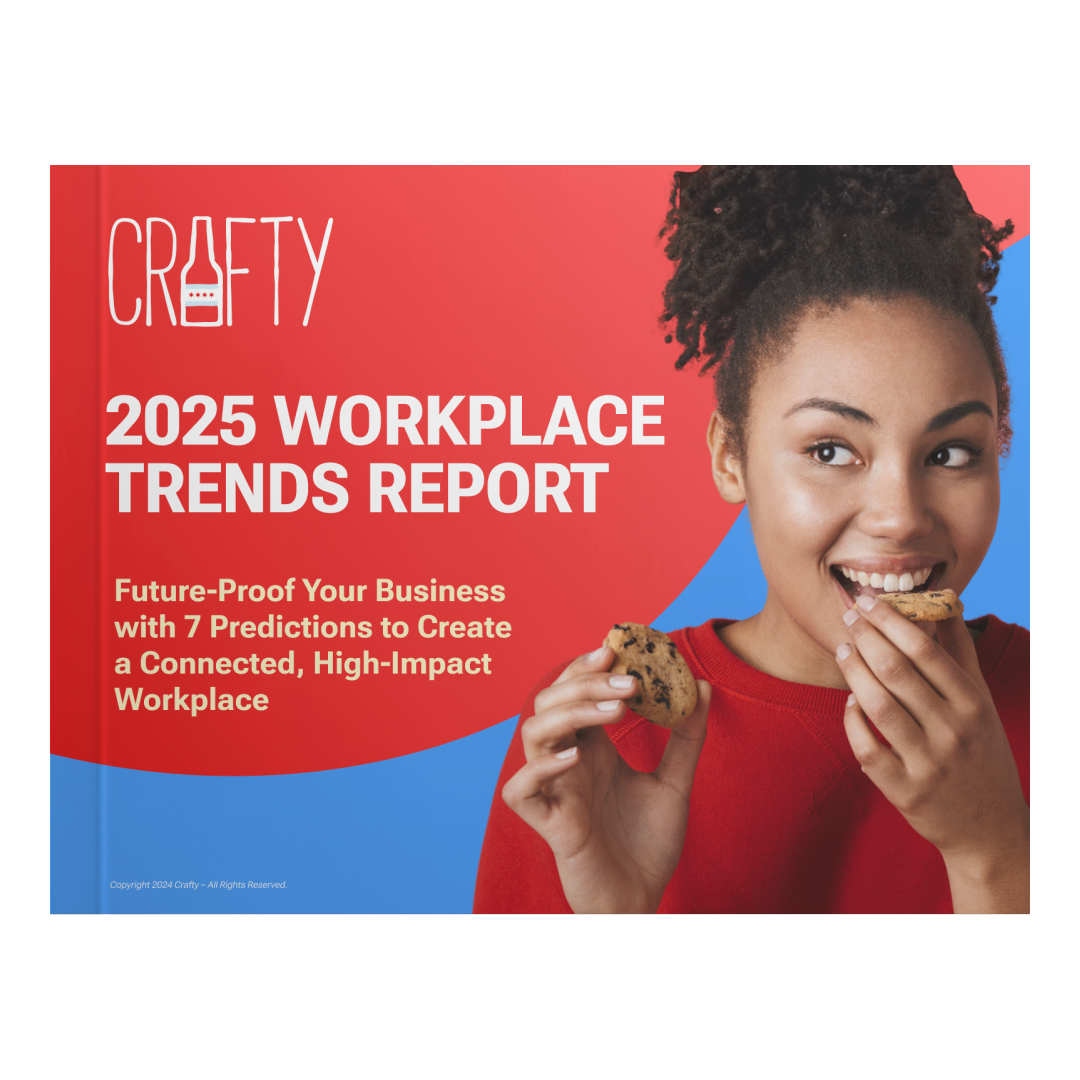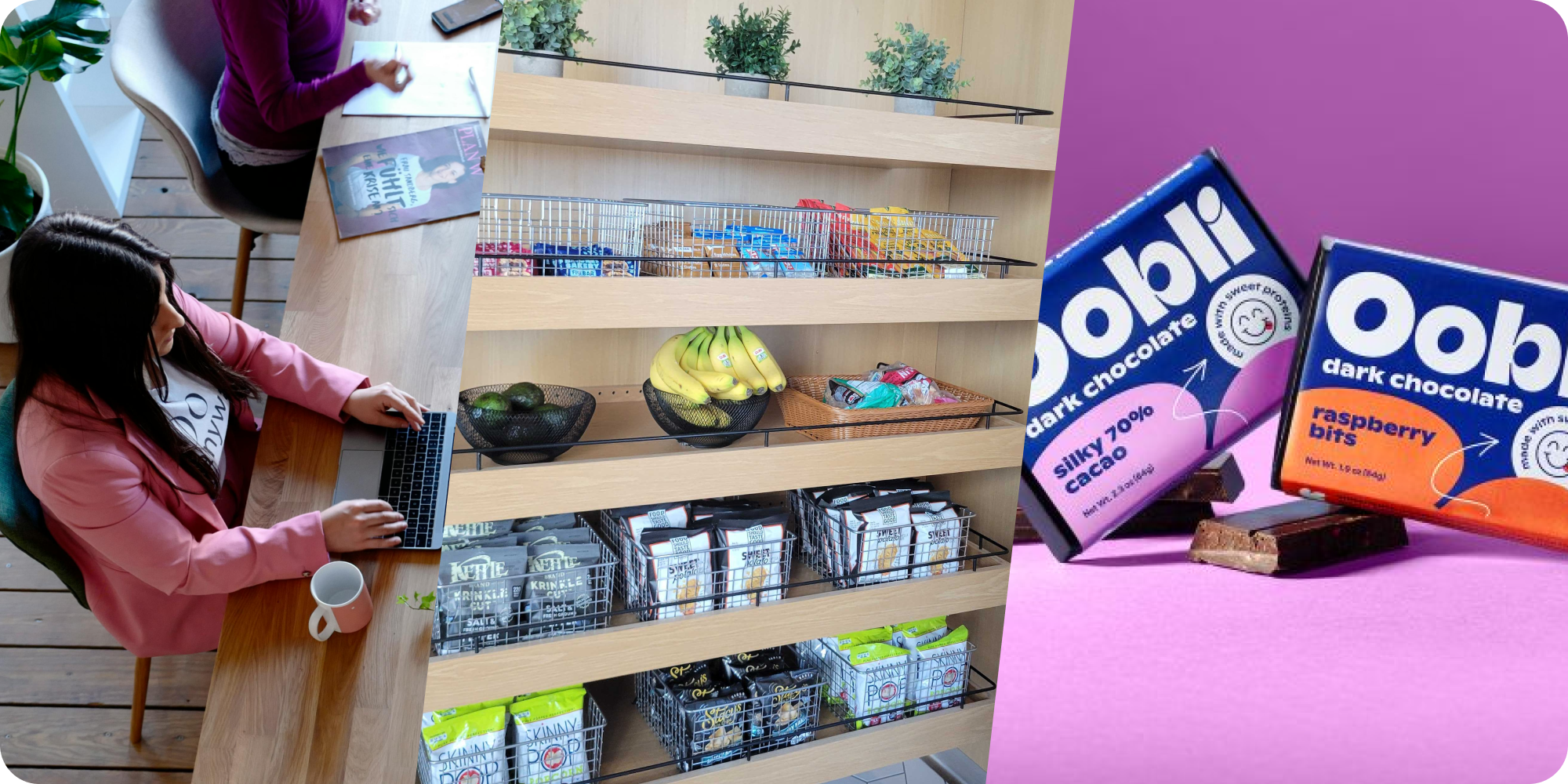3 Workplace Trends Shaping Your Office Breakroom [February 2025]
What does burnout, shifting spending habits, and clean labels mean for your office food service?
✍️ Written by Rebecca Ross
🕚 8-Minute Read • Published Tuesday, February 11, 2025
![Trends for your corporate food service [February 2025] Trends for your corporate food service [February 2025]](https://info.craftydelivers.com/hubfs/Trends%20for%20your%20corporate%20food%20service%20%5BFebruary%202025%5D.png)
Roses are red, violets are blue, your office breakroom can be sweet if you read our insights too.
If last year was about navigating hybrid work, this year is about keeping up with evolving employee priorities. Employees are running on fumes, consumer habits are shifting, the food industry is redefining what ‘healthy’ really means,
Here’s what’s shaping the workplace conversation this month:
The Silent Crisis of High Engagement and Hidden Burnout
DHR Global finds that engagement and burnout are on the rise.

Burnout hit record highs in 2024, but so did engagement—a paradox that should be a flashing warning sign for HR leaders in 2025. Instead of disengaging, many burned-out employees are doubling down on work, creating a hidden crisis that could lead to severe retention challenges.
The Data on Burnout & Engagement:
- 82% of 1,500 white-collar workers reported being “slightly” to “extremely” burned out.
- 39% of the 2,100 employees surveyed cited burnout and exhaustion as their top challenge.
- 88% of respondents also reported being “very” or “extremely” engaged at work despite feeling burned out.
- 67% of employees said a tight job market increased their engagement, suggesting that many felt trapped in their current roles.
Why This Matters in 2025:
The rise of AI, social media fatigue, and political stress have compounded workplace burnout this year. Companies pulled back on hiring and limited internal mobility, causing employees to feel stagnant.
Some employees react by disengaging, but 44% reported throwing themselves even further into work as a coping mechanism—accelerating the burnout cycle. The lack of career growth opportunities left workers feeling “locked in,” leading to more burnout without an escape route.
The tea: Leaders in 2025 must support employees running on empty without killing their drive. Top performers are getting pushed to their breaking point and may decide to leave when the job market improves. Therefore, companies must focus on preventative measures within the workplace that could help employees achieve better balance.
This is where intentional microbreaks come into play. A coffee chat or snack break isn’t just a pause—it triggers oxytocin and dopamine. Why does that matter? Studies have shown that quick breaks to relax, socialize, or engage in cognitive activities were shown to...
- Increase mood
- Increase concentration
- Decrease stress
- Increase emotional resilience
- Heightened brain activity
Smart companies incorporate breaks into their workplace culture, and the office pantry is a focal point for this activity. Employees can’t form meaningful connections when they’re running on empty. Office snacks, coffee, and drinks are natural conversation-starters and serve as fuel for achieving the desired outcomes.
In our 2025 Trends Report, Crafty CEO Nate Rosenstock compares your employees to elite athletes. "Athletes follow a specific routine to perform at their best. If they push too hard, they will break. The same is true for your employees," says Nate. " Employees are people that help your company build, produce, and create. To do that, you need to help them build and maintain energy so they don't crash throughout the day. A thoughtful pantry is a tool to help them be more productive, so they can go through the workday as effectively as they can."
2025 WORKPLACE TRENDS REPORT
7 PREDICTIONS TO FUTURE-PROOF YOUR WORKPLACE
Discover seven research-backed predictions and actionable strategies to transform your workplace into a connection catalyst that drives meaningful results.
Consumer Spending Habits Give Your Pantry A Competitive Edge
McKinsey's latest consumer trends may spark some ideas for your office breakroom.

Employees are tightening their budgets in 2025, but not in the way you might expect. According to McKinsey, consumers are no longer making across-the-board cutbacks—instead, they’re making strategic trade-offs, deciding where to economize, maintain, or splurge. Let’s break it down:
- Economizing on certain food purchases: Consumers are cutting back on nonessential or premium-priced food items where they don’t see enough added value. Many are shopping at budget-friendly retailers like Aldi, which is expanding to meet demand, while major chains like Target and Walgreens are slashing grocery prices to stay competitive.
- Maintaining spending through trade-offs: Instead of cutting their overall food budget, consumers are shifting how they spend. More people are opting for home cooking—often using pre-cut or partially prepared ingredients to save time—rather than spending on pricier takeout.
- Splurging on food experiences: While people are making budget-conscious choices, they’re still willing to spend on items that feel like they add value. Fresh, high-quality food is still a priority, especially as interest in health and wellness grows. Branded food products are holding their ground, but only when they offer a clear advantage.
The tea: Your office pantry isn’t just a perk—it’s an extension of your compensation package if your employees actually utilize and can rely upon it. It's all about the perception.
- If your employees have to fend for themselves or go outside of your pantry for their daily needs, then your pantry isn't saving them any money.
- If your employees don't have to supply their own daily needs, then your pantry is saving them money.
To ensure you stay ahead of the curve, here's our advice on how to apply these insights to your corporate food service program:
- Employees are looking to you to provide healthy options: Employees don't want to compromise their health, so they may look to you to provide fresh, nutrient-dense snacks such as produce, yogurt, protein-rich snacks, etc. Also, remember that health means something different to different people, so even having vegan or gluten-free snacks can contribute to someone's health goals.
- Be strategic in how you merchandise pricier options: If you bring healthier and often pricier products into the mix, you can merchandise them in a way that controls consumption, such as putting them on lower shelves, not putting as many out at a time, or only putting them out at certain times.
- Make small changes over time: You don't have to change every product on the shelf to keep up. Use your product spend and consumption data to see where the opportunities are. For example, if you notice protein bars are flying off the shelves, whereas chips are not getting consumed heavily, maybe this is your opportunity to test a product swap. Remove some chips from your lineup, invest in Quest Protein Chips for a quarter, and see how that performs.
If your pantry program offers strategic choices, it becomes an essential benefit, reinforcing your commitment to employee well-being while keeping your team fueled and focused.
This New Label is Shaping the Future of Clean Eating
The Non-GMO Project just dropped a new clean food label.

The Non-GMO Project just dropped a game-changer: the Non-UPF Verified label, designed to help consumers identify foods without ultra-processed ingredients.
- 85% of consumers looking to cut back on ultra-processed foods.
- Ultra-processed foods make up more than half of all calories consumed in the US.
- 72% of consumers prioritize natural, easy-to-understand ingredients.
Awareness of food processing has never been higher. The Non-GMO Project sees a direct link between GMOs and ultra-processed ingredients, making this new label a natural evolution of their mission for food transparency.
The tea: Even if this label isn't hitting food packaging just yet, it does signal one thing. Your employees are looking at labels and want to see products with recognizable and sustainable ingredients.
Across Crafty-powered pantries, we've seen steps to:
- Prioritize B Corp brands or vegan products to align with sustainability initiatives.
- Swap out products with red dye to ensure employee wellness.
- Add in products that have functional benefits, such as kombucha.
If you're working with anyone but Crafty, doing anything like this can be a major headache. Many of your other options in the office food delivery space rely on the PDF or Excel sheet method when it comes to product information. Not only does it put it on you to analyze, but that information is dated. So if you want to make a change, have fun spending HOURS, if not DAYS, Googling every single product to see what's up.
In the Crafty Platform, all this can be pulled within a few simple clicks:
- Use the B Corp filter to see all brands that meet the environmental standards.
- Use the Vegan filter to see all vegan products.
- Use the Organic filter to see all products that don't contain food dyes.
Having that information in real-time and readily available is important to evolving your pantry to keep up with current consumer trends.
Conclusion
February might be the shortest month, but the workplace trends we’re seeing are anything but small.
- Employees are burning out while still giving 110%.
- Consumer spending habits are shifting in ways that redefine value.
- The food industry is evolving to meet the rising demand for transparency and clean ingredients.
It’s time to double down on how we support employees—because the right office food delivery program isn’t just a perk; it’s a retention and growth strategy. So, as February fades and 2025 picks up speed, ask yourself: Is your workplace fueling success—or just running on fumes?
Want more insights? Connect with our CEO Nate on LinkedIn!



